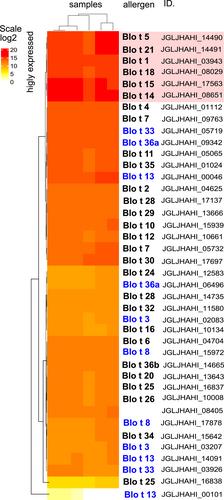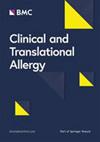The domestic mite Blomia tropicalis is a major source of allergens in tropical and subtropical regions. Despite its great medical importance, the allergome of this mite has not been sufficiently studied. Only 14 allergen groups have been identified in B. tropicalis thus far, even though early radioimmunoelectrophoresis techniques (27 uncharacterized allergen complexes) and comparative data based on 40 allergen groups officially recognized by the World Health Organization (WHO)/IUIS in domestic astigmatid mites suggest the presence of a large set of additional allergens.
Here, we employ a multiomics approach to assess the allergome of B. tropicalis using genomic and transcriptomic sequence data and perform highly sensitive protein abundance quantification.
Among the 14 known allergen groups, we confirmed 13 (one WHO/IUIS allergen, Blo t 19, was not found) and identified 16 potentially novel allergens based on sequence similarity. These data indicate that B. tropicalis shares 27 known/deduced allergen groups with pyroglyphid house dust mites (genus Dermatophagoides). Among these groups, five allergen-encoding genes are highly expressed at the transcript level: Blo t 1, Blo t 5, Blo t 21 (known), Blo t 15, and Blo t 18 (predicted). However, at the protein level, a different set of most abundant allergens was found: Blo t 2, 10, 11, 20 and 21 (mite bodies) or Blo t 3, 4, 6 and predicted Blo t 13, 14 and 36 (mite feces).
We report the use of an integrated omics method to identify and predict an array of mite allergens and advanced, label-free proteomics to determine allergen protein abundance. Our research identifies a large set of novel putative allergens and shows that the expression levels of allergen-encoding genes may not be strictly correlated with the actual allergenic protein abundance in mite bodies.



